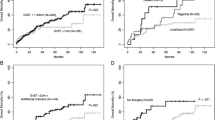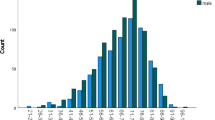Abstract
Background
Gastrointestinal tumors (GISTs) represent the most common mesenchymal tumors of the gastrointestinal tract. There has been limited data on GIST incidence and survival disparities between ethnic groups.
Aims
Assess disparities in incidence and survival among race in the USA in the era of available GIST histologic codes and treatment.
Methods
We queried Surveillance, Epidemiology, and End Results (SEER) database for GIST from 2002 to 2015, with diagnostic code 8936.
Results
Of the 7204 patients identified, 4928 (68.4%) were White, 1308 (18.2%) African American (AA), and 968 (13.4%) were classified as “Other” (American Indian/Alaskan Native, Asian/Pacific Islander). The overall incidence rate (IR) was 0.75 per 100,000. IR was highest among AA at 1.37/100,000, but 0.65/100,000 for Whites, 1.10/100,000 for Asians/Pacific Islanders, and 0.28/100,000 for American Indians/Alaskan Natives. The GIST incidence was twice as high for AA as for Whites (rate ratio [RR]: 2.12; 95% CI: 1.98–2.26; p < 0.001). There was higher proportion of Whites than AA, who underwent surgical extirpation. Median overall survival (OS) and GIST specific survival (GSS) were not reached for all race, which indicates more than half of the patients were still alive at end of follow-up period. In multivariate Cox model, belonging to “Other” had better OS (adjusted hazard ratio [aHR]; 0.73, 95% CI: 0.55–0.95, P = 0.021) for GIST, but no difference in prognosis and OS for AA and White [(aHR for whites; 0.84, 95% CI: 0.69–1.02, P = 0.071), AA = reference]. There was no difference in GSS among races.
Conclusions
Significant racial disparity in incidence and overall survival for GIST exists, and efforts should be made to bridge this gap and improve outcomes for all races. The overall incidence rate for GIST was noted to be 7.5 per 1 million, and IR of GIST was twice as high for African Americans as compared to Whites. The “Other” racial group (American Indians/Alaskan Natives, Asians, and Pacific Islanders) had superior OS as compared to African Americans and Whites.


Similar content being viewed by others
Explore related subjects
Discover the latest articles and news from researchers in related subjects, suggested using machine learning.References
Perez EA, Livingstone AS, Franceschi D, Rocha-Lima C, Lee DJ, Hodgson N, et al. Current incidence and outcomes of gastrointestinal mesenchymal tumors including gastrointestinal stromal tumors. J Am Coll Surg. 2006;202(4):623–9.
Tran T, Davila JA, El-Serag HB. The epidemiology of malignant gastrointestinal stromal tumors: an analysis of 1,458 cases from 1992 to 2000. Am J Gastroenterol. 2005;100(1):162–8.
Blanke C, Eisenberg BL, Heinrich M. Epidemiology of GIST. Am J Gastroenterol. 2005;100(10):2366.
Hirota S, Isozaki K, Moriyama Y, Hashimoto K, Nishida T, Ishiguro S, et al. Gain-of-function mutations of c-kit in human gastrointestinal stromal tumors. Science. 1998;279(5350):577–80.
Khanna A, et al. Is adjuvant 5-FU-based chemoradiotherapy for resectable pancreatic adenocarcinoma beneficial? A meta-analysis of an unanswered question. J Gastrointest Surg. 2006;10(5):689–97.
DeMatteo RP, et al. Long-term results of adjuvant imatinib mesylate in localized, high-risk, primary gastrointestinal stromal tumor: ACOSOG Z9000 (Alliance) intergroup phase 2 trial. Ann Surg. 2013;258(3):422–9.
Cheung MC, Zhuge Y, Yang R, Koniaris LG. Disappearance of racial disparities in gastrointestinal stromal tumor outcomes. J Am Coll Surg. 2009;209(1):7–16.
Day JC. Population projections of the United States, by age, sex, race, and Hispanic origin: 1992 to 2050. Bureau: US Department of Commerce, Economics and Statistics Administration; 1992.
Tiwari RC, Clegg LX, Zou Z. Efficient interval estimation for age-adjusted cancer rates. Stat Methods Med Res. 2006;15(6):547–69.
Ma GL, Murphy JD, Martinez ME, Sicklick JK. Epidemiology of gastrointestinal stromal tumors in the era of histology codes: results of a population-based study. Cancer Epidemiol Prev Biomarkers. 2015;24(1):298–302.
Miettinen M, Sobin LH, Lasota J. Gastrointestinal stromal tumors of the stomach: a clinicopathologic, immunohistochemical, and molecular genetic study of 1765 cases with long-term follow-up. Am J Surg Pathol. 2005;29(1):52–68.
de Raedt T, Cools J, Debiec–Rychter M, Brems H, Mentens N, Sciot R, et al. Intestinal neurofibromatosis is a subtype of familial GIST and results from a dominant activating mutation in PDGFRA. Gastroenterology. 2006;131(6):1907–12.
Fletcher CD, et al. Diagnosis of gastrointestinal stromal tumors: a consensus approach. Int J Surg Pathol. 2002;10(2):81–9.
Din OS, Woll PJ. Treatment of gastrointestinal stromal tumor: focus on imatinib mesylate. Ther Clin Risk Manag. 2008;4(1):149–62.
Nilsson B, Bümming P, Meis-Kindblom JM, Odén A, Dortok A, Gustavsson B, et al. Gastrointestinal stromal tumors: the incidence, prevalence, clinical course, and prognostication in the preimatinib mesylate era--a population-based study in western Sweden. Cancer. 2005;103(4):821–9.
Tryggvason G, Gíslason HG, Magnússon MK, Jónasson JG. Gastrointestinal stromal tumors in Iceland, 1990-2003: the icelandic GIST study, a population-based incidence and pathologic risk stratification study. Int J Cancer. 2005;117(2):289–93.
Leoncini E, Carioli G, la Vecchia C, Boccia S, Rindi G. Risk factors for neuroendocrine neoplasms: a systematic review and meta-analysis. Ann Oncol. 2016;27(1):68–81.
Miettinen M, Fetsch JF, Sobin LH, Lasota J. Gastrointestinal stromal tumors in patients with neurofibromatosis 1: a clinicopathologic and molecular genetic study of 45 cases. Am J Surg Pathol. 2006;30(1):90–6.
Ashktorab H, Kupfer SS, Brim H, Carethers JM. Racial disparity in gastrointestinal Cancer risk. Gastroenterology. 2017;153(4):910–23.
Kawanowa K, et al. High incidence of microscopic gastrointestinal stromal tumors in the stomach. Hum Pathol. 2006;37(12):1527–35.
Dong E, Duan L, Wu BU. Racial and ethnic minorities at increased risk for gastric Cancer in a regional US population study. Clin Gastroenterol Hepatol. 2017;15(4):511–7.
Nguyen T, Ramsey D, Graham D, Shaib Y, Shiota S, Velez M, et al. The prevalence of helicobacter pylori remains high in African American and Hispanic veterans. Helicobacter. 2015;20(4):305–15.
Li K, et al. Genetic progression in gastrointestinal stromal tumors: mechanisms and molecular interventions. Oncotarget. 2017;8(36):60589–604.
Giuliano K, Nagarajan N, Canner J, Najafian A, Wolfgang C, Schneider E, et al. Gastric and small intestine gastrointestinal stromal tumors: do outcomes differ? J Surg Oncol. 2017;115(3):351–7.
Miettinen M, Lasota J. Gastrointestinal stromal tumors: pathology and prognosis at different sites. Semin Diagn Pathol. 2006;23(2):70–83.
Bolen JC, et al. State-specific prevalence of selected health behaviors, by race and ethnicity--behavioral risk factor surveillance system, 1997. MMWR CDC Surveill Summ. 2000;49(2):1–60.
Freeman HP. Poverty, culture, and social injustice: determinants of cancer disparities. CA Cancer J Clin. 2004;54(2):72–7.
Henschke UK, Leffall LD, Mason CH, Reinhold AW, Schneider RL, White JE. Alarming increase of the cancer mortality in the U.S. black population (1950-1967). Cancer. 1973;31(4):763–8.
Nikfarjam M, Kimchi E, Shereef S, Gusani NJ, Jiang Y, Liang J, et al. Surgical outcomes of patients with gastrointestinal stromal tumors in the era of targeted drug therapy. J Gastrointest Surg. 2008;12(11):2023–31.
Geiger HJ. Racial and ethnic disparities in diagnosis and treatment: a review of the evidence and a consideration of causes. Unequal Treat. 2003;417.
Dimick J, Ruhter J, Sarrazin MV, Birkmeyer JD. Black patients more likely than whites to undergo surgery at low-quality hospitals in segregated regions. Health Aff (Millwood). 2013;32(6):1046–53.
Haider AH, et al. Racial disparities in surgical care and outcomes in the United States: a comprehensive review of patient, provider, and systemic factors. J Am Coll Surg. 2013;216(3):482–92 e12.
Rubin JL, Sanon M, Taylor DC, Coombs J, Bollu V, Sirulnik L. Epidemiology, survival, and costs of localized gastrointestinal stromal tumors. Int J Gen Med. 2011;4:121–30.
Ng EH, et al. Prognostic factors influencing survival in gastrointestinal leiomyosarcomas. Implications for surgical management and staging. Ann Surg. 1992;215(1):68–77.
DeMatteo RP, Lewis JJ, Leung D, Mudan SS, Woodruff JM, Brennan MF. Two hundred gastrointestinal stromal tumors: recurrence patterns and prognostic factors for survival. Ann Surg. 2000;231(1):51–8.
Joensuu H, et al. Adjuvant imatinib for high-risk GI stromal tumor: analysis of a randomized trial. J Clin Oncol. 2015;34(3):244–50.
Kelley RK, Venook AP. Nonadherence to imatinib during an economic downturn. N Engl J Med. 2010;363(6):596–8.
Acknowledgments
We are thankful to Paschal Apanga (University of Nevada, Reno) for his help and suggestions.
Author information
Authors and Affiliations
Contributions
MBU, MR, BDB, TH, and GN conceived the idea and prepared manuscript. MR, KGK, MBU drafted the initial manuscript. MBU performed the computations. WY helped with computation and statistical analysis. TD helped with manuscript writing. SA, NG, TH guided the preparation process and writing of the manuscript. All authors read and approved of the manuscript prior to publication.
Corresponding author
Ethics declarations
Conflict of Interest
The authors declare that they have no conflict of interest.
Ethical Approval
There was no IRB approval needed for this research, as it utilizes public, de-identified data.
Additional information
Publisher’s Note
Springer Nature remains neutral with regard to jurisdictional claims in published maps and institutional affiliations.
Electronic supplementary material
ESM 1
(DOCX 18 kb)
Rights and permissions
About this article
Cite this article
Ulanja, M.B., Rishi, M., Beutler, B.D. et al. Racial Disparity in Incidence and Survival for Gastrointestinal Stromal Tumors (GISTs): an Analysis of SEER Database. J. Racial and Ethnic Health Disparities 6, 1035–1043 (2019). https://doi.org/10.1007/s40615-019-00605-9
Received:
Revised:
Accepted:
Published:
Issue Date:
DOI: https://doi.org/10.1007/s40615-019-00605-9




